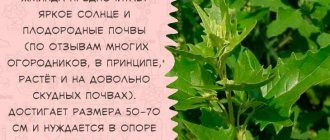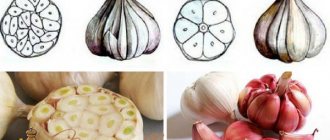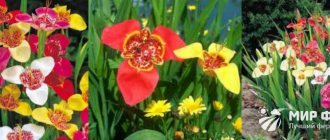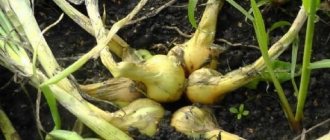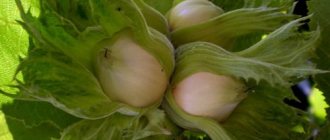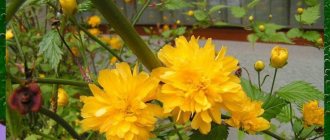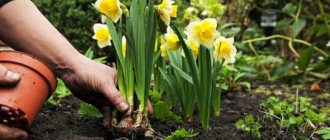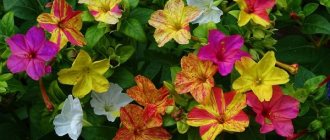Beans: plant description
Beans are a herbaceous annual plant from the Legume family. The stem of the plant is erect, thickened, reaching a height of 30 to 120 cm. The leaves are unpaired and pinnate, the color is green. It has a developed powerful root that goes deep into the soil up to 1.5 meters. The bean inflorescence is a raceme with 4-12 flowers 2.5-3.5 cm in size. The bean blooms with white flowers with a black spot on the wings of the petals. Flowers open in the afternoon. During flowering, the beans look attractive.
The fruit of the plant (bean) is a pod up to 30 cm long, which contains 2 or more seeds of yellow, green, brown, purple, black, the size and shape of which depends on the plant variety. There are small-seeded, medium-seeded and large-seeded varieties of beans, which differ from each other not only in color, size, but also in yield and ripening time. Of all garden crops, beans are the most cold-resistant and undemanding in terms of thermal conditions. The seeds of the plant sprout already at a temperature of 3-4 degrees Celsius, and adult specimens can withstand frosts of up to 4 degrees. At an air temperature of 19-22 degrees, young plants actively begin to grow and develop.
Differences between planting beans in the garden and at home
The difference between planting legumes in open ground and at home in a pot is the choice of where to sow the material and fertilizing:
- To grow legumes in open ground, predecessors (plants that were grown in the selected location last year) are of great importance. It’s better if potatoes, pumpkins, and cucumbers grew there before.
- Legumes can only be planted in the same place after 5 years.
- When growing in open ground, it is recommended to use saturated phosphorus-potassium fertilizers.
- Bean sprouts do not like soil that is too acidic, so alkaline soil is a good choice. To correct the condition of the soil, before sowing the seeds, you need to add a deoxidizer to the soil, for example, ash, chalk, dolomite.
- When growing in indoor pots, many are overfed with fertilizers. In this case, a lot of greenery grows (a large bush) to the detriment of the harvest.
Bean varieties
Modern varieties of beans have high nutritional value and excellent taste. Breeders divide beans into two main groups: northern and Western European varieties. Northern varieties produce high yields in regions with a temperate climate, while Western European varieties are grown in southern regions with a hot, dry climate.
- Russians are black . One of the most famous mid-early varieties, widely used for planting in the northern zone of Russia. The bush reaches a height of up to 60 cm, blooms with white flowers and black spots. The shape of the beans is slightly curved, the length of the pod is 7-8 cm. The dark purple seeds have an oblong oval shape; when ripe, the bean valves do not open.
- Belarusian. They belong to a mid-season variety, the height of the shoots is from 60 cm to 1 meter. The flowers are white, spotted. The bean is straight, up to 11 cm long; when ripe, the fruit flaps crack. The seeds are light brown in color and elongated in shape. The variety is widely known in Ukraine, Belarus, and Latvia.
- Windsor green and white . Mid-season varieties. The plant is compact, stem height 0.6-1 m. The shape of the beans is elliptical, slightly flattened, with fleshy, green valves that open when ripe, contains 3 seeds. Varieties differ in seed color.
- Virovsky . The beans belong to the mid-early variety. A plant up to 1 meter high with an erect stem. The flowers are large. The bean pod has a curved shape; 3-4 large, milky-colored seeds ripen in it.
DISHES FROM BEANS
The beans have a delicious taste that is somewhat nutty. There are many recipes for their preparation. Here are a few of my favorites.
In sauce
Cut 400 g of bean pods into pieces, boil until tender in salted water, drain in a colander. Prepare the sauce (1.5 tbsp. milk, 1.5 tsp. flour, 0.5 tbsp. cream, 1/4 tbsp. tomato puree, 1 tbsp. butter, salt) and heat the beans in it, do not bringing to a boil.
Burgundy beans
Cut 750 g of peeled green bean pods into 2-3 parts, simmer until tender in a small amount of water. Add 50 ml of red wine and 250 g of carrots, boiled separately and cut into slices. Season with salt, pepper, simmer. Add 2-3 tbsp. chopped greens. Fry diced lard (125 g) and 2 onions cut into rings in a frying pan. Place the beans and carrots on a plate and place the roast on top.
Dumplings
Pass 250 g of boiled beans (without pods) through a meat grinder. Mix the mixture with the soaked bread, chopped onion, add 1 egg, salt, pepper, and herbs to taste. Stir, make dumplings, roll in crushed breadcrumbs, fry on both sides.
Beans: growing features
Beans are daylight plants that require little heat. Bean seeds begin to germinate actively at low temperatures and are not afraid of frosts down to 4 degrees, so the seeds are sown in the spring, at the earliest possible date. The plant feels most comfortable at moderate temperatures up to 22 degrees Celsius. Higher air temperatures can lead to falling flowers and empty flowers, and therefore to unripe fruits.
Beans love moisture and are sensitive to drought. It has been noted that the highest yields of beans are observed when there is a large amount of rainfall during their flowering period.
Beans are not only a tasty and nutritious product, but also a useful garden crop. Like all plants of the Legume family, the roots of beans form nodule bacteria, which enrich the soil with nitrogen and make it looser and more suitable for the full growth and development of other vegetable crops. The roots and stems of beans, embedded in the ground after ripening and harvesting, are valuable fertilizer for the site. Also, the powerful branched root system of beans prevents weeds from developing, reliably protecting the fertile soil layer from being washed out by heavy rainfall.
Choosing a site for planting beans
When choosing a place to plant beans, you should give preference to a lighted area of the garden with loamy, fertile, slightly acidic or neutral soils. A very important criterion for choosing a place to plant beans is soil moisture, so lowlands, row spacing of other vegetable crops, as well as small hills from which the snow melts early are allotted for planting them. However, there should be no stagnation of moisture in the soil. Cold and too wet soil is completely unsuitable for growing vegetable beans - most likely the seeds will rot and will not sprout. Areas where potatoes, cabbage, and cucumbers were previously grown are suitable for planting the plant. Garden areas where legumes were previously grown are not suitable: beans, peas, soybeans, lentils, in order to ensure vegetable crop rotation.
The benefits of beans for the garden
The need to grow beans on the site is due to the fact that they:
- enrich the soil with nitrogen (there is no need to use artificial fertilizers);
- reliably protect vegetable crops due to the release of phytoncides that suppress the growth of pathogenic bacteria, infections, and fungal diseases;
- improve the structure and quality of the soil;
- repel moles, malicious pests of vegetables and berries;
- restore the soil after the growing season when used together with mustard, rye, and lupine.
Beans are a universal, healthy product that is used to prepare a variety of dishes. They also enrich the soil. Growing beans does not require special skills or technology. Be sure to plant them on your plot, and they will become indispensable crops in your arsenal of vegetables!
Watch the video! Bean harvest
Planting beans in open ground
Vegetable beans are an unpretentious crop that can withstand fairly low temperatures, so they can be planted in early spring, when the soil begins to warm up and the threat of ground freezing has passed.
Preparing the soil for planting beans with seeds
Preparing the soil for planting beans is carried out in the fall. The soil should be dug well, using a spade, as the plant has a powerful root system. When digging, organic fertilizers are added: compost, mullein, manure (3-4 kg per 1 square meter). The exception is bird droppings, which contain a high nitrogen content. The soil is also enriched with phosphorus fertilizers and ash, which reduces the acidity of the soil. In the spring, before planting seeds, the soil, which has become compacted over the winter, is dug up, adding 10-20 g of superphosphate and 20 g of potassium salt.
Timing for planting bean seeds in open ground
Sowing bean seeds in the ground is carried out in late April - early May. The earth should warm up sufficiently, but be moistened, retaining most of the melt water. For central Russia, the optimal period when to plant beans in the ground is from May 7 to May 14. With later planting, the development and growth of seedlings is weaker, and the plant becomes susceptible to fungal diseases and attack by harmful insects.
Less commonly, the seedling method is used for planting, which is used to obtain an early harvest and is suitable for regions with late spring. To do this, the seeds are soaked in water for up to 15 hours and planted in separate containers in early April, grown in greenhouse conditions. After 30-35 days, the seedlings are ready for planting in open ground.
How to ensure high germination rates for bean seeds
Bean seeds germinate at low temperatures (from 4 to 10 degrees), but night frosts can cause their death. Before planting, it is necessary to inspect all the seeds and select only mature ones that are ready for planting. When examining, pay attention to seeds with a small hole - this seed has been damaged by the grinder. By breaking the seed you can find the pest larva.
You can plant both dry and soaked seeds in the ground. Before sowing, the seeds should be soaked on a saucer with damp gauze in two layers for 24-48 hours. You should not delay planting seeds that have swollen in water, as they may “choke” and not germinate.
How to plant beans in open ground with seeds
- The beans are planted immediately in moist soil, in 2 rows, keeping a wide row spacing of at least 45 cm, to make it easier to care for them.
- For the black Russian bean variety, the row spacing can be reduced to 30 cm.
- The seeds are deepened to a depth of 5-7 cm, keeping a distance of 10-15 cm between them. It will not be difficult for a powerful sprout to break through to the light. After planting, the beds need to be watered.
- For beans, you can select separate beds in the garden, or you can combine them with other vegetable crops by planting seeds between the rows. Combined plantings provide protection for garden crops from aphid attacks.
Care
Watering . The beans can be kept for quite a long time without watering, but at the beginning of growth they need quite a lot of water. If there has been no rain for a long time, the plantings need to be watered. As a rule, they water 2 times a week, at a rate of at least 10 liters of water per 1 square meter. meter.
Loosening . The soil around the plants must be periodically loosened and weeds removed. Treatment of row spacing is carried out several times to a depth of 8-12 cm; The first loosening is carried out after the appearance of the second leaf, then they are repeated as the soil crust forms and is stopped when the plant height is 50-60 cm.
During the second and third loosening, the plants are hilled, which helps strengthen the root system and increase the plants' resistance to winds.
Feeding . If the plants grow slowly, they are fed with potassium and nitrogen fertilizers - 10-15 g per 1 square meter. m.
Garter . Only tall varieties need a garter (to facilitate the process of caring for them).
To do this, we install a trellis on them, which can be done as follows:
- After planting, we drive stakes into the soil along the edges of the rows - supports (height 1-1.2 m);
- When the seedlings grow a little, we stretch the wire onto the stakes at intervals of 30 cm;
Beans: caring for garden crops
Caring for beans is not difficult; it is enough to provide the plant with regular watering, loosening the soil, and hilling. It is necessary to ensure that weeds do not interfere with the active growth and development of young seedlings, so it is necessary to weed more often. When the plant grows and gains strength, it will inhibit the growth of weeds and the need for weeding will disappear by itself. As soon as the bean stalks reach a height of 50 cm, they are earthed up; hilling is carried out 2-3 times throughout the season. Hilling protects the bean stems from gusts of wind and makes the plant more stable.
Feeding beans
In the process of loosening the soil, liquid complex organic-mineral fertilizers are applied between the rows (up to 10 g of superphosphate, 5 g of ammonium nitrate and 5 g of potassium salt must be added per square meter of soil).
Watering the beans
Regular watering is an important part of care when growing beans. The plant especially needs abundant watering during the flowering period, when fruit sets. However, one should not allow excess and stagnation of moisture in the soil, which can lead to root rotting or active growth of the vegetative mass of the plant, which will lead to low yield.
Pinching the tops of the beans
Pinching the top of a plant during the flowering period is an effective method of protecting young shoots from attack by aphids, which love to feast on the sap of a young plant. The tops of the stem 10-15 cm long are cut off. Pinching also helps the fruits ripen evenly.
Tying beans, creating support for shoots
Depending on the variety, the upright branched stem of the bean can reach a length of more than a meter. For the stability of tall varieties, a support is used to which the plant stems are tied. Pegs 1 meter high are used as support, with twine or rope stretched between them; you can also tie the stem directly to a separate peg.
Vegetable beans: growing, planting and care
Vegetable beans are useful to grow in the garden not only for food, but also for feeding other crops. Beans are an unpretentious crop when growing. Caring for them in open ground requires only timely watering, loosening and hilling.
Planting beans in open ground is done with seeds in early spring . To grow beans correctly, get a good harvest and enrich the garden soil, it is enough to follow simple rules of agricultural technology.
Conditions for growing beans
The conditions for growing beans are largely determined by their cold resistance, and the technology is similar to the principles of growing other legumes.
- Bean seeds begin to germinate at positive temperatures of 3-4 °C.
- Beans begin to be sown very early in the spring .
- The grown plant can easily withstand short-term frosts down to 4 °C below zero.
- A temperature of 17-18 °C will be sufficient for optimal growth of vegetable beans. The beans will feel most comfortable at a temperature of 20-22 °C.
- But at temperatures above 25 °C, the beans suffer: the flowers that have formed fall off and the fruits do not ripen.
Vegetable beans have virtually no heat requirements and are considered one of the most cold-resistant crops among other legumes, slightly second only to peas.
Soil for growing beans
- Beans are prescribed fertile, loamy and clayey soils.
- They need a neutral or slightly alkaline reaction in the environment.
- Beans also tolerate poor soil relatively well.
- At the same time, they are demanding of moisture and prefer well-moistened soil.
Unpretentious beans also have their own requirements:
- they need a bright place, these are long-day plants .
Therefore, they cannot tolerate a site in the shade and do not do well in acidic and sandy soils.
Growing beans from seeds
Bean seeds can be sown immediately in open ground, after thoroughly moistening the planting site. But if you want to help the seeds germinate faster and more reliably, and also get rid of possible pathogens, the seeds can be treated before planting.
- First, bean seeds are soaked in water at room temperature for 5-6 hours (overnight is possible).
- If the seeds are very dry, they need more time to soak - it is better to leave them for 12-20 hours, periodically changing the water.
- After soaking for 5 minutes, warm up in hot water at a temperature of approx. 50°C.
- Then immediately immerse in cold water.
- After this treatment, the seeds can be sown.
Bean seeds remain viable for a very long time: from 5 to 10 years, of course, if they are stored correctly:
- in a dry place,
- without temperature changes,
- away from heating devices,
- avoiding direct sunlight.
Planting beans in open ground
When growing beans from seed, you need to know the best time to plant them.
Bean planting dates
The timing of planting beans in open ground is the same as for peas: late April - early May .
- The earlier you sow beans, the better - they will have a higher yield, larger seeds with a higher protein and starch content, and the plants themselves will be more resistant to aphid damage.
- The timing of planting beans to obtain fruits at technical ripeness is quite extended - they can be sown until the end of June.
Bean planting scheme
For the tape planting method, the following planting scheme is recommended:
- distance between tapes 70 cm,
- Leave about half a meter between the rows.
- Seeds are sown from each other at a distance of 12-15 cm.
- Place 2-3 seeds in the nest and plant them to a depth of 6-8 cm.
When planting in two lines on beds, the seeding density is observed:
- for tall varieties, 20 seeds per 1 m² according to a 20 by 20 cm pattern,
- for low-growing (dwarf) varieties - 28 seeds per 1 m².
The square-cluster sowing method is also used , when 5-6 seeds are placed in one nest.
Preparing the soil for planting beans
The key to proper agricultural technology is careful preparation and fertilization of the soil for growing beans. When preparing a place for planting beans, it is advisable to apply mineral or organic fertilizers.
- of organic fertilizer when planting beans .
- According to the rules of bean agricultural technology, they are planted after any crop 1-2 years after the application of manure .
____________________________________________________________________
ORGANIC FERTILIZERS: TYPES AND METHODS OF APPLICATION _____________________________________________________________________
You can also “give” a balanced mineral composition ((per 1 m²):
- 5-9 g ammonium nitrate,
- 26-31 g of simple superphosphate,
- 4-11 g of potassium chloride.
This mixture can be replaced with complex mineral fertilizer:
- when sowing, you can add 1 tsp for every 2 m of row. nitroammosophics ,
- nitrophoska (5-7 g per 1 sq. m) when digging
A mixed mineral-organic composition is also offered for fertilizing the bean planting site (per 1 m²):
- 1 tbsp. l. potassium chloride,
- 1 tbsp. l double superphosphate,
- half a bucket of organic matter and 2 cups of ash.
All this is thoroughly dug up. microfertilizers will also be needed , especially copper . After such fertilization, the beans do not need further fertilizing.
Joint planting of beans
It is not for nothing that beans, like other legumes, are successfully used in green manure.
- Beans protect any plantings and crops very well from the wind.
- Therefore, if we consider joint planting, it is better to plant beans along the perimeter of the beds and potato field.
- Some gardeners even note that such circular closed plantings of beans repel moles. In this case, beans of the Black Russian , sown at a distance of 12-15 cm from each other, are considered especially effective.
Beans are ideal for crop rotation. Beans are an excellent precursor for any crop, because... saturate the soil with nitrogen from nodule bacteria. _______________________________________________________________________
ALTERNATING CROPS TO INCREASE FERTILITY __________________________________________________________________________
Beans in plantings with potatoes
- It is not recommended to plant beans together with potatoes.
- The beans, growing faster and more vigorously, will deprive the new potatoes of light, which is so important for the growth and development of large, healthy tubers.
- In addition, both potatoes and beans are very demanding of potassium, and the beans will take this useful microelement from the soil, which is why the potatoes will clearly lack potassium .
- Another useful feature of beans - the presence of nodule bacteria that saturate the soil with nitrogen - can cause scab in potatoes . As a result, potato yields will be greatly reduced due to their proximity to beans.
____________________________________________________________________
JOINT PLANTING: WHAT TO PLANT WITH WHAT
Caring for beans in open ground
Caring for beans is minimal and includes watering, loosening and hilling, and rarely weeding and fertilizing. Caring for young beans
- Young plants need a one-time feeding with herbal infusion and regular loosening.
- Young plants need a little help and care that they are not disturbed by weeds. Therefore, in the first time after sowing, you need to pay attention to weeding.
- When the seedlings grow and gain strength, the weeds will not interfere with them; the beans themselves will begin to inhibit the growth of weeds.
Hilling beans
- When the beans reach a height of 50 cm, they are hilled.
- During the bean planting season, you will need to loosen and prune the beans 2-3 times.
- Hilling up simultaneously with loosening contributes to greater plant stability and helps withstand winds.
Watering the beans
- Beans should be watered before mass flowering only during dry periods.
- Once flowering begins, watering should be regular.
- At the same time, make sure that there is no waterlogging, otherwise the vegetative mass of the beans will begin to actively grow to the detriment of the development of flowers and fruits.
Feeding beans
- If you fertilize the soil well before planting beans, they do not need additional fertilizing.
- If the soils are poor, you can pamper the plants with a treat made from slurry - but no more than once per season.
Pinching the tops of the beans
- As soon as the beans begin to bloom en masse, they need to be pinched - this is an effective method of protection against aphids, which eat young shoots.
- Tops 10-15 cm long are cut off, buried or burned.
- Pinching also promotes uniform ripening of the fruit.
Supporting and tying beans
Beans have a straight, non-lodging stem, which can be either low in height, only 20 cm, or quite tall - up to 180 cm. Therefore, for tall varieties it is necessary to provide support.
- You can stick meter-long pegs at the ends of the bed and stretch twine between them every 25-30 cm, and tie the plants to it.
- This will be easier and simpler than tying each bush to a separate peg.
Diseases and pests of beans
Uninvited guests of garden plots - crows and rooks - are very fond of pulling out young shoots of beans. Here you will have to provide methods for protecting and scaring birds away from the site. When using high-quality planting material and proper care, beans rarely get sick . However, their plantings are susceptible to attack by fungal diseases:
- root spot,
- black leg,
- ascochyta blight,
- rust,
- fusarium.
Fitosporin is recommended as a medicine - just use the solution to water the soil and plants. One of the most dangerous pests is the root weevil . Its larvae eat nodules on the roots, and the pest itself feeds on young leaves, causing the plant to weaken and die. of aphids also attack beans - their activity occurs in the second half of summer. Long shoots of beans are more susceptible to damage by black melon aphid , which attacks plantings in August. To combat such pests, you can use Fitoverm . _____________________________________________________________________
PEST CONTROL IN THE VEGETABLE GARDEN
Picking beans
They begin harvesting from the beginning of July and harvest many times during the season.
- For direct consumption, the fruits must be collected at technical ripeness, when the bean leaves are juicy, soft, and tender.
- Grains in milky ripeness size approx. 1 cm - it occurs approximately 2 weeks after flowering.
- Harvesting begins from the lower part of the stem - there the fruits ripen faster.
- If harvested earlier, the seeds are not as tasty and even have a bitter taste.
Remember that eating raw beans is dangerous to your health, just like undercooked ones, because... they contain toxic substances
. Therefore, only carefully heat-treated legumes can be eaten.
- The biological maturity of the beans will be indicated by the darkening of the valves - they acquire a black or brown tint.
- The time to harvest fruits at biological ripeness is when the pods wither and begin to droop.
- They can be broken out by hand or the plants can be pulled out by the roots (this is easier to do in damp weather), tied into bundles and hung in the shed to ripen.
- When the fruits are dry enough, they can be easily peeled and stored.
After harvesting, the above-ground part of the beans is cut off and burned, and the underground part is dug up or composted. Nodule bacteria located on the roots will become a good green manure fertilizer, saturating the soil with nitrogen.
Harvesting beans
The first bean harvest begins in summer; the crop is harvested several times per season. For fresh consumption, green, juicy and tender beans are collected. Green bean grains are at milky ripeness approximately 2 weeks after flowering. The crop is harvested starting from the lower part of the stem, where the fruits ripen faster.
- Green (unripe) bean fruits are ideal for salads and side dishes. And more mature fruits with ripened seeds are suitable for making soups.
- Collection of bean seeds for storage and subsequent propagation is carried out after the fruit valves darken and begin to open. Select viable seeds for storage. To determine their germination capacity, the seeds are placed in a saline solution. In this case, empty beans will float to the surface, and mature ones will remain at the bottom of the dish.
- Bean seeds remain viable for 5-10 years. Store them in a dry, dark place, away from heating devices, where the temperature is stable and there is no humidity.
- After harvesting, the above-ground part of the plant is cut off and burned, and the soil, along with the roots, is dug up.
- The root system of beans makes excellent compost and ideal soil fertilizer. To enrich the soil on the site with nitrogen, the roots of the beans can be pulled out of the ground and buried in the ground during autumn digging.
Harvesting beans
If I plan to eat the beans whole (grains with leaves), I remove the pods when the grains inside reach 1 cm in size. If there are only the grains themselves, then they must be removed at the stage of milky ripeness. I carefully break out the pods (so as not to damage the stem) with my hands, selectively, starting from the bottom ones. Only beans with mature seeds are suitable for winter storage.
The crop is harvested depending on the purpose of use. Young green fruits for consumption with leaves are harvested when they are still unripe and soft, with seeds no more than 1 cm. In this ripening phase they are especially tender and tasty. When the beans reach a standard size, the leaves are no longer suitable for consumption.
When growing beans, it is worth considering the growing season. Cleaning is carried out in 3-4 steps, every 8-10 days. The fruits are carefully broken out with your hands so as not to damage the bush. If the seeds are planned to be left for a future harvest, they are removed when the valves become hard and black.
After harvesting, the beans are sorted, selecting those that are suitable, large, of the correct shape and of the appropriate size. To determine the germination of fruits, they are placed in a solution of table salt and empty ones float to the surface. To prevent pest control, plants are treated with Granazol or TMTD several weeks before the predicted sowing. On the day of planting, the beans are treated with Nitrogin.
Control of diseases and pests of beans
Beans are a vegetable crop that is resistant to various types of diseases and pests. Common plant diseases include:
- Black bean aphid . A pest that attacks the stems of young plants in the summer. Most often, aphids attack the top of the stem. Leads to deformation and curvature of the stem. During active growth of the stem, it is recommended to pinch off all the tops of a plant up to 15 cm long to prevent aphids from appearing. For prevention, the plant is treated with karbofos or Fitover.
- Sprout fly . Often beans are attacked by a small pest - the sprout fly, which lays eggs in the soil, under the shoot. The fly larvae feed on the bean root. To protect the plant from the pest, it is necessary to regularly remove weeds and loosen the soil under the bushes.
- Nodule weevil . Looks like a small gray bug. This is one of the most dangerous pests of beans, capable of destroying the entire plant. Insect larvae feed on root nodules, and the weevil itself eats young foliage, as a result of which the plant becomes weaker and eventually dies. If a pest is detected, the plant should be sprayed with dust at the rate of 10 grams per square meter.
- The bean weevil is an insect that harms the plant during the flowering period when fruit sets. It lays larvae on young ovaries; after a few days, the larvae penetrate the seed and feed on its contents, thereby harming the future harvest. Caryopsis larvae are dangerous because they can overwinter in seeds intended for planting in the spring. To prevent infection of young seedlings, the seeds are soaked in a saline solution.
In addition to pests, young seedlings are susceptible to some diseases, which are usually associated with waterlogging of the soil. Among them are:
- Black leg . A disease characterized by the formation of a dark coating on the root collar of a plant. Leads to rapid withering and death of the shoot. The culprit of the disease is a fungus, infection of which occurs through the soil. The disease progresses in cool, damp spring and is observed when seeds are sown late in open ground.
- Chocolate (brown) spot . A disease characterized by the appearance of dark brown spots on the leaves and stem of the plant. If chocolate spotting is detected on the leaves, they must be removed so that the disease does not spread throughout the entire shoot. The plant does not need to be treated with chemicals.
In addition, significant damage to the bean harvest is caused by uninvited guests of gardens - rooks and crows, who pull out young shoots along with the roots. To prevent bird attacks, it is necessary to provide methods of repelling them.
Beans are a vegetable crop that is healthy and nutritious for our body, and by planting it in the garden, we receive double benefits. In addition to the high yield of tasty fruits, the soil on the site is fertilized and saturated with nitrogen. Particular attention must be paid to choosing a site for planting legumes and knowing when to sow beans in open ground in order to obtain high yields. Delicious, nutritious dishes made from beans are a source of vegetable protein and valuable substances that will diversify your diet and fill your body with vitamins and microelements for the whole year.
How to prepare beans for planting in the spring in the garden and at home
The choice of variety is of no small importance in the effective cultivation of beans. There are 2 types of beans available for sale:
- ordinary varieties intended for dry and fresh use;
- pod varieties (fresh or frozen pods are eaten).
Common common legumes include:
- hyacinth beans;
- regular beans;
- Vinga chinensis;
- fava beans;
- chickpeas
The most popular leguminous crops are:
- green beans;
- black Eyed Peas;
- Azuki beans;
- Mash.
Important! The most common and high-yielding variety is Russian black beans. Windsor white beans and Belarusian beans are well cultivated.
Planting beans requires proper processing. Before planting seeds in open ground or a pot at home, it is recommended to prepare them - soak them in warm water for a day. This procedure will increase germination and early yield.
Purchased seeds undergo special treatment before sale; when using your own beans, they should be treated with a salt solution (30 g of salt per 1 liter of warm water). You need to soak the crop seeds in it for 10 minutes.
How to Plant Beans
The further soaking procedure is carried out using a special technology:
- The peas are placed in a deep plate.
- Pour water 1 cm above the level of the beans.
- Leave the seeds in this form until the morning (at least 10 hours).
After soaking, it is important to carefully monitor:
- If the seeds float, they cannot be used; they are susceptible to grain infection.
- Those seeds that have sunk to the bottom are suitable for use.
How to germinate beans for early germination:
- Rinse the seeds under warm running water, wrap in gauze, and place in a bag.
- Leave to germinate for 2 days at room temperature.
- It is recommended to check the seeds twice a day for mucus and rotting.
Is it possible to plant beans with potatoes?
You can plant beans with potato bushes - the plants enter into symbiosis, repelling insect pests: the Colorado potato beetle, weevil and sprout fly. Nodule bacteria enrich the soil with nitrogen, and potato leaves protect the beans from wind and frost.
How to grow potatoes and beans in the same hole and why to do it
If you grow these crops in one bed, then:
- The volume of legume harvest increases both at the stage of milky ripeness and mature, darkened pods.
- Plant symbiosis increases their protection against pests. The beans protect against wireworms and the Colorado potato beetle.
- Potatoes do not deplete the soil due to nodule bacteria on legumes. The root system of the latter prevents weeds from growing.
It is not recommended to grow both plants in the same hole. Tall bean stalks will over time shade the potatoes and rob the bushes of most of the nutrients in the soil. The result will be a bountiful harvest of beans and meager potato tubers.
The best option is to plant legumes and potatoes in one bed or in one row. In this case, the beans are placed between the potatoes. Their number of beans in the garden should be 2-3 times less than potatoes, because they consume more nutrients from the soil.
When using early-ripening potato varieties, legumes are sown as a compactor after the vegetable crop has emerged. While the potato bushes are developing, the legumes will form foliage. After harvesting the tubers, pods will begin to set. This practice allows you to harvest from both crops.
This is interesting:
How to plant bean seeds correctly
Choose a site for growing legumes that is well-lit and on a hill. If there is water in a low-lying garden bed after rains, the grains and roots will simply rot.
Then plant the beans
Crop rotation in the garden is a prerequisite for getting a good harvest. Therefore, to grow beans, choose a bed where last year you grew tomatoes or potatoes, cucumbers or pumpkins, cabbage or zucchini.
You can plant legumes along a potato field or along the edge of a root bed. But only in such a way that they do not block the light from the plants.
Soil preparation
Beans will grow and develop well in fertile neutral or slightly alkaline soils. When digging, it is recommended to add compost and fertilizers to the soil. For each square meter of bed:
- 3 kg of well-rotted compost;
- 10-15 g of superphosphate;
- 20 g potassium salt.
It is better to apply fertilizers in advance so that they have time to dissolve and be absorbed into the soil.
Bean planting pattern and depth
When planting along the edge of a field or bed in one row, the distance between plants is about 20 cm. If you plant beans in one bed, then the planting pattern is: 10 by 40 cm. Where there are 10 cm between the holes in the row, and the distance between the rows themselves is 40 or 45 cm.
It is best to plant bean seeds to a depth of 6-8 cm. If planted superficially, then the grown loaches will need to be tied up. And at such a planting depth, legume plants will not need a garter. Their roots will be deep in the ground, due to which the stems hold firmly, without any support.
Attention! If the soil on your site is heavy, then the planting depth should be less - from 3 to 5 cm. Be sure to water the crops, even if the soil in the garden bed is wet
In dry weather, monitor the soil moisture. The earth should not dry out
Be sure to water the crops, even if the soil in the garden bed is wet. In dry weather, monitor the soil moisture. The earth should not dry out.
If planted correctly, bean seedlings will appear very quickly. In the future, when growing them, you will only need to remove weeds and monitor the soil moisture in the garden bed. If it rains regularly, watering may not be necessary.
Depending on when the bean seeds were planted, harvesting will begin in July or August.
Planting scheme
Based on how to properly plant and cultivate beans and which scheme to choose, the level of germination and yield depend. You can plant beans using 2 main methods:
- Single-row, wide-row method, which provides row spacing of at least 40-45 cm. Thanks to this, adult plants do not interfere with each other. The method refers to relatively fast ripening of sprouts.
- A two-line tape method, in which there are 45 cm between the tapes and 20 cm between the lines. There should be at least 10 cm between each seed in the row. The seeds should be planted approximately 8 cm into the ground. In general, the seeding rate in this case is 25-30 g per 1 m².
The plant grows well alone in the garden or together with other crops, such as potatoes. To prevent seedlings from freezing, they can be covered with portable plastic film in the spring.
If you want to get an earlier harvest, legumes can be planted as seedlings. 25-30 days before planting, it is worth planting the seeds at home in peat pots. Seedlings can be planted in open ground in mid-May.
How to plant legumes on a plot? Standard instructions for growing legumes in open ground are as follows:
- Prepare planting material.
- Sow peas according to the scheme in pre-fed, fluffed soil.
- Cover with soil, compact, and water.
- Cover the bed from the last frosts and birds (you can use, for example, agril or film).
Features of caring for bean beds
If you already have experience in cultivating peas, then growing and caring for beans will not cause difficulties due to the similarity in agricultural technology. As noted above, they are moisture-loving plants, but during the period of fruiting and ripening, watering should be reduced, especially if there is sufficient precipitation. In general, beans in the country grow “on their own”, without unnecessary supervision. However, like any cultivated plant, they require some care. Here are the key points for successful cultivation:
- nodule bacteria require active access of oxygen to function, so we must not forget about loosening after each watering;
- overmoistening (especially on heavy soils) leads to the development of root rot;
- thickened plantings are most often affected by downy and powdery mildew;
- Timely removal of weeds plays an important role in creating a healthy phytosanitary environment;
- It is recommended to tie tall varieties to a trellis, which can be made from wooden stakes and medium-thick wire;
- during the period of mass flowering, pinching the upper shoot by 10 cm is carried out (this measure reduces the likelihood of aphid colonization and makes fruit ripening uniform);
- It is enough to carry out one fertilizing with infusion of chicken manure during the period of active growth;
- The yield of beans will be higher if the fruits are collected in several stages as they reach the stage of milky ripeness; its maximum value can be 0.5 - 1.5 kg per 1 sq. meters (largely depends on the variety and air temperature during the flowering period).
Even novice gardeners can follow these simple recommendations on how to grow beans in your summer cottage. Even after harvesting, vegetable bean bushes can be useful for your garden: tops trimmed at the base will become an excellent green fertilizer for other vegetable crops, and powerful, highly branched roots with nodules left in the soil will improve the structure and enrich the substrate with nitrogen.

